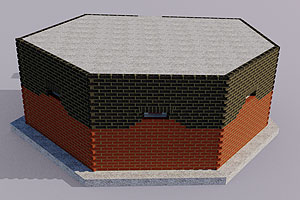Time Team - Lost WW1 bunker
Posted: 10 November 2008 22:49
This evening's Time Team Special examined the excavation of a WW1 brigade HQ near Paschendaele. I've been searching for a similar structure dug in East Sussex by the Canadians in 1941.
The diagram below is similar to that seen in the programme and comes from the Manual of Field Engineering Vol.II (1936).

The dugout being excavated was known as "Vampire" and was 14m below ground; built of timber, girders and corrugated iron, the entire structure had flooded.
Some fascinating footage showed the interior of the dugout, although it seems that the layout differed from the generic plans seen above.
Unfortunately, a couple of collapses prevented entry to the full system.
I mentioned a similar dugout in East Sussex; I won't get into the minutiae of it, as I haven't fully disentangled the facts from the documents, but it seems that the local Canadian infantry brigade wanted an underground battle headquarters.
From what I gather, an HQ was built using Anderson shelters, but this was abandoned soon after completion, partly because of its location.
A fresh location was found for the HQ, which is described thus:
The HQ will consist of a 4 room (possible more) with two exits and a connecting gallery.
It was decided that the dugout...will be used as an advanced HQ only... The personnel at Adv. HQ will probably consist of the Brigadier, Brigade Major, Intelligence Officer, Signals Officer with one or two clerks and signal men.
This sounds as though it might be a scaled-down version of the plan above.
But what did it look like? There's no further description, but the HQ might have been built of timber and girders, or possibly using mine tunnel shuttering such as was used in the Royal Navy underground HQ at South Heighton, or the tunnels that link the observation post in the cliff face below Newhaven Fort.
The image below is of a 3D model I built some time ago, and shows how the battle HQ might have looked inside:

Is the HQ still there? Probably not; such structures were probably demolished during the postwar clean-up operation. However, it may be that only the entrances were blown in or sealed, and that the tunnels still exist...
- Pete

Email:
Blog Latest

Bishopstone reveals its pillbox secrets
18 October 2021

Pillbox or Observation Post?
10 June 2020

Uncovering the hidden secrets of a pillbox
8 June 2019

Review of 2018
31 December 2018

Wartime Christmas in East Sussex (2)
24 December 2018
Jargon-buster
Anderson shelter
An air raid shelter for 6-10 persons intended for civilian use. Constructed from panels of heavy-duty corrugated iron, the shelter was to be dug 3 feet into the ground and covered over with spoil. The army also used Andersons as battle headquarters and in the construction of underground posts for Home Guard Auxiliary Units.
This site is copyright © Peter Hibbs 2006 - 2024. All rights reserved.
Hibbs, Peter Time Team - Lost WW1 bunker (2024) Available at: http://pillbox.org.uk/blog/216585/ Accessed: 27 July 2024
The information on this website is intended solely to describe the ongoing research activity of The Defence of East Sussex Project; it is not comprehensive or properly presented. It is therefore NOT suitable as a basis for producing derivative works or surveys!